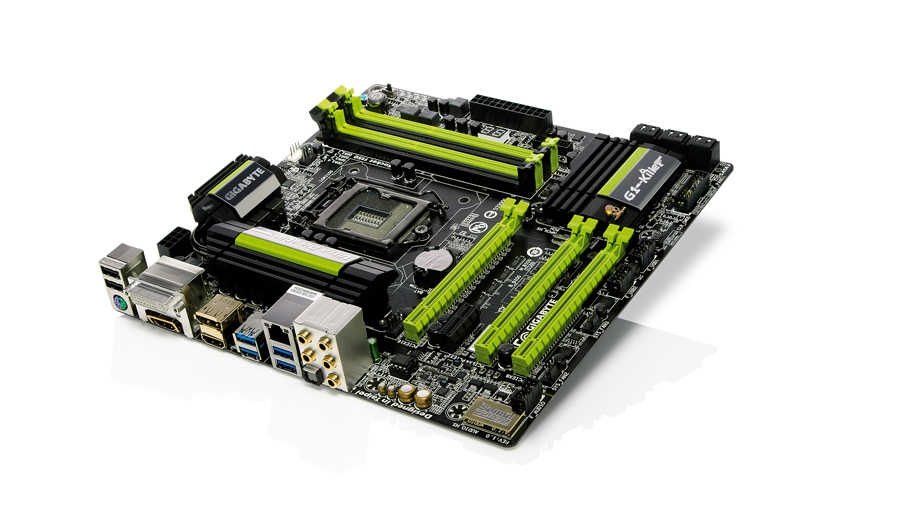TechRadar Verdict
Pros
- +
Changeable op-amps
- +
Electrically isolated audio
- +
Full overclocking options
- +
Good performance
- +
All the Z87 trimmings
Cons
- -
Some issues with BIOS
Why you can trust TechRadar
Making mobos is a bit of a thankless task. You have to jump up and down, shout very loud, give yourself a silly name with a vague military connection or a general head-banging vibe, and then plaster yourself in lots of lurid fluorescent colours. Only then do you have a hope of actually standing out.
The result is often attention-grabbing gimmicks of dubious value when it comes to actually doing anything with your PC. Enter, therefore, the Gigabyte Z87 G1 Sniper M5, replete with gaudy green detailing and a name that shoots to kill. Whoops.
But hold on, because Gigabyte has been careful to take aim at a few things that might actually matter in a motherboard. First, let's cover the basics. It's Haswell month on PC Format, and that means we're talking mobos with the new LGA1150 socket.
We're actually a bit peeved about Intel forcing yet another new socket on us, but we can't blame Gigabyte or this board for that. The simple fact is, if you want Haswell, you need a new board. And if you need a new board, you'll want something with the Z87 chipset. It's the true replacement for the Z77, and is basically the no-compromise option.
You get full access to overclocking features (CPU-dependent, of course) at the same time as support for the graphics core, including Quick Sync video transcode, the maximum number of USB and SATA interfaces, and all the little extras that come with a premium chipset - things like Intel Rapid Storage and six SATA 6Gbps sockets. All Z87s get that stuff.
What marks the Sniper out are details like an electrically insulated separation on the main PCB, which protects the audio-out ports from the annoying interference you get with some boards.
Swap shop
What's more, in what Gigabyte claims is a world first, the Sniper also has swappable op-amps, or operational amplifiers. This is another sound-related feature, and to cut a long story short, the op-amp chip influences the characteristics of the sound the board produces.
By offering a swappable op-amp (one additional chip is provided with the board and others are available separately), Gigabyte is giving you a way to fine tune the sound to specific presets.
Then there's the BIOS, which gives you both an old-school text-based interface and a more graphical option. The latter can render up to 1080p, looks lovely and includes some handy status information covering most of the prevailing metrics, including temps, voltages and so on - handy when you're deep into a menu and have suddenly forgotten where things happen to be at.
We had compatibility issues with the BIOS's HD mode with some 3D cards too, and the graphical mode generally had issues regards making settings changes stick.
Benchmarks
Single threaded performance
Cinebench R11.5: Index score: Higher is better
ASUS Z87-PRO: 1.76
GIGABYTE G1.SNIPER M5: 1.72
INTEL DZ87KLT-75K: 1.77
ASUS SABERTOOTH Z77: 1.64
Memory bandwidth performance
SiSoft Sandra: GB/S: Higher is better
ASUS Z87-PRO: 17.47
GIGABYTE G1.SNIPER M5: 17.45
INTEL DZ87KLT-75K: 17.56
ASUS SABERTOOTH Z77: 16.41
Gaming performance
Shogun 2: FPS: Higher is better
ASUS Z87-PRO: 38.1
GIGABYTE G1.SNIPER M5: 37.1
INTEL DZ87KLT-75K: 37.9
ASUS SABERTOOTH Z77: 35.6
Verdict
As for performance, the Sniper auto-overclocking feature cranks things up pretty heavily - right up to 4.8GHz. Not that any Haswell chip will run that fast without falling over.
At stock clocks, performance is pretty much on a par with Asus's Z87-Pro. All of which means it's a nice overall proposition, and a winner if quality, configurable audio is high up your list.
Technology and cars. Increasingly the twain shall meet. Which is handy, because Jeremy (Twitter) is addicted to both. Long-time tech journalist, former editor of iCar magazine and incumbent car guru for T3 magazine, Jeremy reckons in-car technology is about to go thermonuclear. No, not exploding cars. That would be silly. And dangerous. But rather an explosive period of unprecedented innovation. Enjoy the ride.
